Fluid bed granulation, also known as one-step granulation, is a method in which the three steps of mixing, granulation and drying of conventional wet granulation are completed in a closed container at one time. In 1959, Dr. Wurster from Wisconsin, USA first proposed fluid bed granulation technology, and then the technology developed rapidly and was widely used in the pharmaceutical, food and chemical industries. In the 1980s, China successively introduced fluid bed granulation equipment. In recent years, due to the GMP certification faced by the pharmaceutical industry, fluid beds have been widely used in pharmaceutical factories in China and abroad. Our company will review the principles and advantages of fluid bed granulation, the selection of fluid bed types, the influence of equipment parameters, process parameters, and prescription parameters on granulation in the fluid bed granulation process.
1 Principle Of fluid Bed Granulation
In the fluid bed granulator, the compressed air and the binder solution are atomized from the nozzle in a certain proportion and sprayed onto the material powder in the fluid state on the fluid bed. First of all, the droplets wet the contacted powder and coalesce around it to form particle cores. At the same time, the continuously sprayed droplets fall on the surface of the particle cores to create a bonding and bridging effect, and make particle cores and particles combine with each other to gradually form larger particles. After drying, the liquid bridges between the powders become solid bridges, that is, porous particles with rounded shapes are obtained. Because the whole process of fluid bed granulation is not affected by external force and is only affected by the air flow in the bed, the obtained particles have low density and low particle strength, but the particle size is uniform, and the fluidity and compression formability are good.
2 Fluid Bed Type Selection
Fluid bed granulation equipment consists of air compression system, heating system, spray system and control system. The main structure is composed of a container, an air distribution plate, a nozzle, a filter bag, an air inlet and outlet, and a material discharge outlet. According to the different spraying methods, it is divided into three categories: top-spray fluid bed, rotary shear-spray fluid bed, and bottom-spray fluid bed. Fluid bed granulation generally chooses top jet fluid bed. In recent years, in order to give full play to the advantages of fluid bed granulation, a series of multifunctional composite granulation equipment with fluid bed as the parent material has also appeared. Such as our company’s new multi-functional fluid bed, agitated fluid granulator, rotary fluid granulator, agitated rotary fluid granulator, etc. Now we only discuss the fluid bed granulation.
3 Advantages Of Fluid Bed Granulation
Although fluid bed granulation is affected by many factors, this technology still has many advantages compared with other granulation methods.
1. Dry mixing, wet mixing, stirring, particle forming and drying of materials are all completed in the same fluid bed equipment, which reduces a lot of operation links and saves production time.
2. Making production in a sealed environment can not only prevent the contamination of drugs from the outside world, but also reduce the chance of operators coming into contact with irritating or toxic drugs and excipients, which is more in line with GMP requirements.
3. The prepared particles have uniform particle size, good fluidity and good compression formability.
4. Drugs that are very low in the components can be more uniformly distributed in the resulting granules.
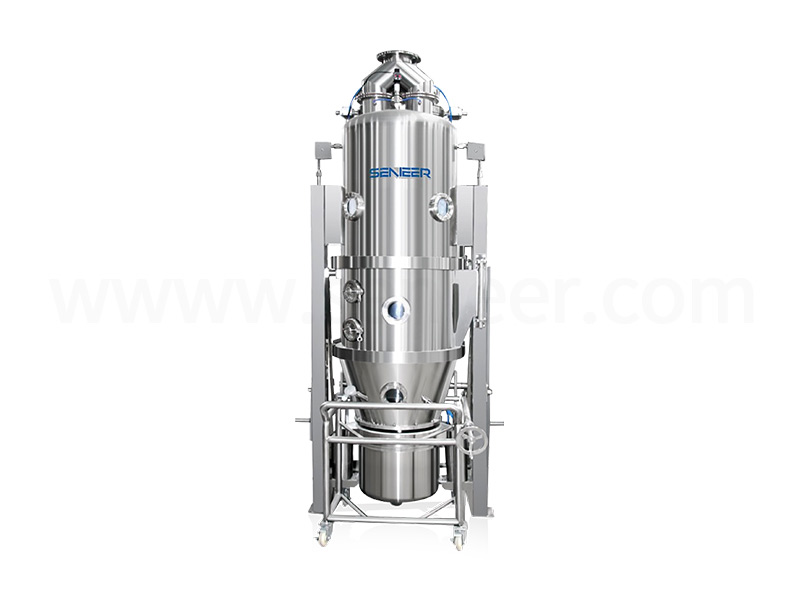
In addition, the fluid bed can also produce multi-layer and multi-phase functional particles, which shows infinite charm to people.
4 Influencing Factors Of Fluid Bed Granulation
Fluid bed granulation is a complex process, which is affected by many factors, which can be summarized as equipment factors, process factors, prescription factors, etc. The equipment factor is related to the structure of the granulator, the process factor is closely related to the actual operating conditions, and the prescription factor is related to the type and concentration of the granulating material and binder.
4.1 Equipment Factors
In a fluid bed granulator, both the air distribution plate and the container have an effect on the movement of the particles. The material and shape of the container have a greater impact on particle motion. It is not only necessary to ensure that the material powder can reach a good fluid state, but also to prevent the material from adhering to the wall of the container, otherwise a large amount of fine powder will be generated during the granulation process. At present, there are many kinds of materials for the container, mainly stainless steel with low carbon content (sus304), and the shape is basically a cylinder or cone with a narrow bottom and a wide top. Most manufacturers of fluid beds have adopted polishing treatment for the cylinder. During the granulation process, 1-2 layers (about 180 meshes) of stainless steel screen will be placed on the air distribution plate, which not only plays the role of bearing materials, but also weakens the influence of the air distribution plate on particle movement to a certain extent. There are even early foreign literature reports that the air distribution plate has little effect on particle motion.
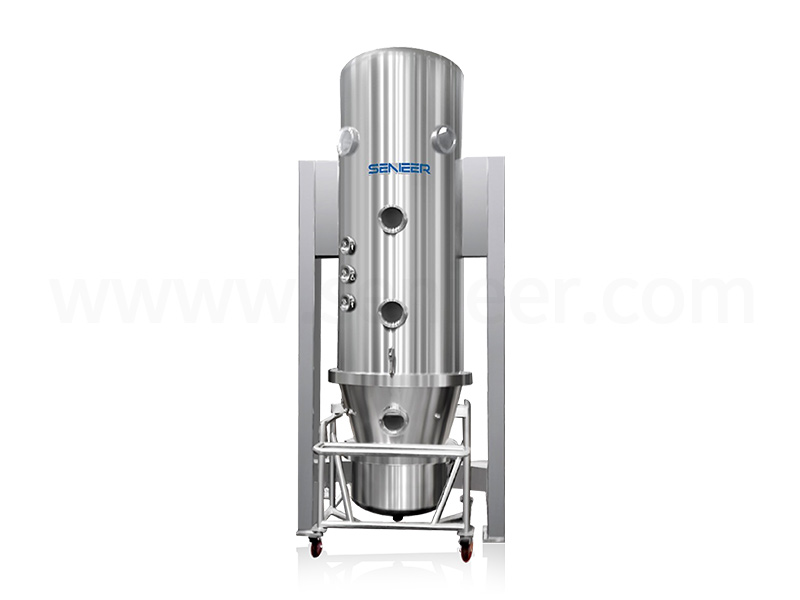
When using a top-spray fluid bed, the position of the nozzle will affect the spray uniformity and the wetting degree of the material. In order to make the particle size distribution as narrow as possible, the spray area should be adjusted as large as the wet bed surface area. If the position is too high, the distance from the nozzle to the material will be longer, which will increase the volatilization of the liquid medium so that the material cannot be fully wetted, resulting in an increase in fine powder in the particles, showing the phenomenon of spray drying. If the nozzle position is too low, the adhesive cannot fully contact the material after atomization, the particle size obtained is uneven, and the front edge of the nozzle is prone to spray obstacles. When using a rotary shear jet fluid bed granulation, the configuration of the mixer also has a large impact on the granulation. Foreign reports have compared the influence of two mixers with different shapes of impellers on granulation. Under the same conditions, the reference mixer caused a lot of wet materials to adhere to the wall of the mixer, while the other mixer did not have this phenomenon. In addition, the type of spray gun (single air flow, dual air flow, high-speed flywheel and high-pressure airless spray gun, etc.) and the material of the filter bag also have a certain influence on the quality of particles.
4.2 Process Factors
4.2.1 Inlet Temperature
The inlet temperature should be controlled within an appropriate range. If the solvent of the binder is water during granulation, the inlet temperature is generally set in the range of 25 to 55 °C according to the material properties and the required particle size. Experiments have proved that for the same material, when the inlet temperature increases from 25 ℃ to 55 ℃, the particle size of the obtained particles decreases from 450 um to 240 um. If the solvent of the adhesive is an organic solvent such as ethanol, the inlet temperature should be slightly lower, generally in the range of 25 to 40 °C. If the temperature is too low, the solvent cannot be swept away in time and the powder is excessively wetted, and some material powder will adhere to the wall of the vessel and cannot be fluid, which may easily cause the particles to stick together and agglomerate. If the temperature is too high and the air inlet temperature is too high, the droplets of the adhesive may be dried prematurely and cannot be effectively granulated, and may also cause changes in the properties of some temperature-sensitive materials. When drying, the inlet temperature is generally set to about 60 ℃. If the temperature is too high, the solvent on the surface of the particles evaporates too quickly, preventing the inner layer of the solvent from diffusing outward, resulting in a large number of particles that are dry on the outside and wet on the inside. If the temperature is too low and the drying time is too long, a lot of fine powder will be produced.
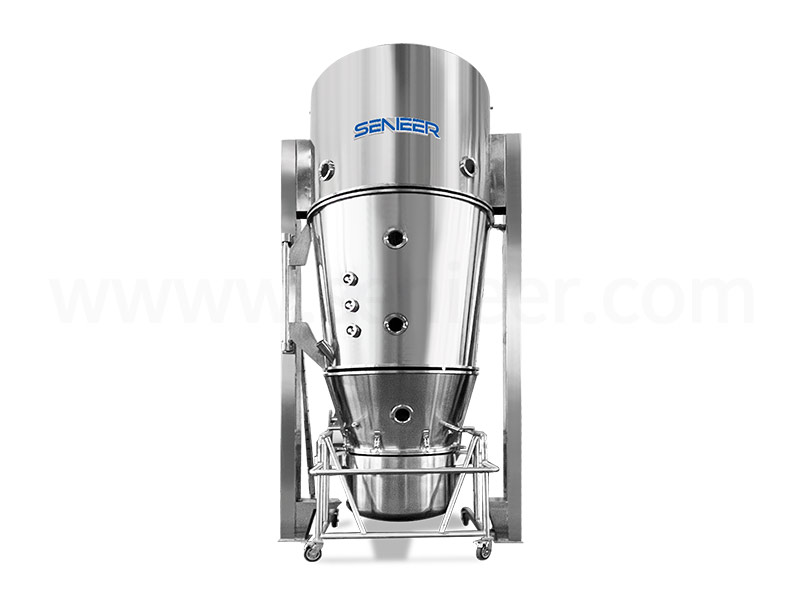
4.2.2 Fluid Air Volume
Fluid air volume refers to the amount of air entering the container, which should be at a value that makes the material in an ideal fluid state. During shotcrete granulation, if the air volume is appropriate, the material is in a good fluid state, and the heat exchange is in a balanced state, which is beneficial to granulation. If the air volume is too large, the moisture of the adhesive will volatilize too quickly, and the adhesive force will be weakened. At the same time, the adhesive droplets cannot fully contact the material, so that the particle size distribution is wide and the fine powder is large. The solvent cannot be swiped away in time, and the fine powder of the material is excessively adhered. If the air volume is not increased in time, large particles with a large particle size will appear, which will form a large agglomerate and cause a collapsed bed, which is a very serious accident in industrial production. During the granulation process, the filter bag sometimes adsorbs a lot of powder of the material, resulting in a decrease in the actual fluid air volume, and the fluid air volume should be appropriately increased.
4.2.3 Atomizing Air Pressure
The function of atomizing air is to make the binder solution form droplets, and the particle size of the droplets is directly related to the particle size of the obtained particles. Relevant experts believe that the greater the atomizing air pressure, the smaller the particle size of the obtained droplets, The more uniform, the smaller the particle size of the resulting particles. When the spray pressure is too low, on the one hand, the atomized droplets will increase, on the other hand, the spray cone angle of the atomized droplets will decrease, and the range of the wetted particles will be reduced, resulting in uneven distribution of the atomized droplets, which is easy to produce large wet lumps on a local scale. Because the fluid state of the material will be affected by the dual action of the fluid air and the atomizing air, the pressure of the atomizing air also has a great influence on the fluid state of the material. The fluid state will be weakened, and the fluid air volume should be increased; otherwise, it should be comprehensively considered in the operation.
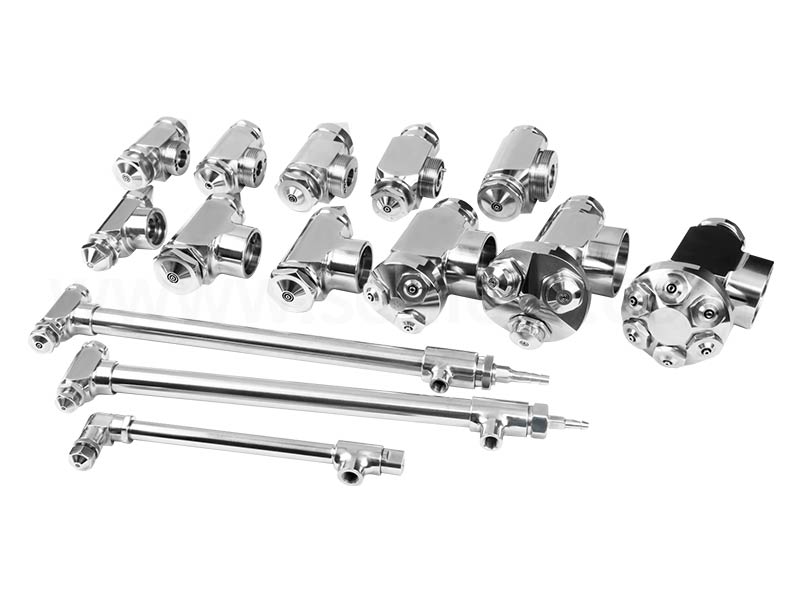
4.2.4 Flow Rate Of Adhesive
The flow rate of the binder and the temperature of the inlet air determine the humidity in the granulator. If the inlet temperature remains unchanged, increase the flow rate of the binder, the droplet size of the binder and the humidity in the granulator. The wet particles cannot be dried and agglomerated in time, which is easy to cause the collapsed bed. Under the same conditions, when the flow rate of the binder is too low, the particle size is smaller and the fine powder is more, which not only prolongs the operation time, but also easily blocks the nozzle. If necessary, the flow rate should be controlled according to the viscosity of the adhesive solution. If the viscosity of the adhesive is too large, the flow rate of the adhesive can be appropriately reduced, but the inlet temperature should be increased, otherwise it will easily cause nozzle blockage and bed collapse. When the viscosity of the adhesive is low, the flow rate should be larger.
4.3 Prescribing Factors
4.3.1 Properties Of Materials
In fluid bed granulation, particle size and particle size distribution are the most important physical properties of materials. The smaller the particle size of the material powder, the larger the surface area of the material, and the larger the amount of binder required. It has been reported abroad that when the flow rate of the binder remains unchanged, the smaller the particle size of the material powder, the smaller the obtained particles. When the particle size of the material powder becomes smaller, to obtain the same particles, the flow rate of the binder should be increased. However, the particle size of the material powder should not be too small, otherwise it is easy to cause adhesion between particles, which is not suitable for fluid bed granulation. The particle size distribution of the material is wide, the obtained particles are firm and the porosity is low; on the contrary, the obtained particles are loose and the porosity is high.
When granulating with hydrophilic materials, the powder and the binder are mutually miscible and easy to aggregate into granules, so it is suitable to use fluid bed granulation. The powder particles of hydrophobic materials need to rely on the bridging effect of the binder to bond together. After the solvent evaporates, the particles are formed. Whether it is a hydrophilic or hydrophobic material, the particle size of the powder should not be greater than 280 um, otherwise the obtained particles will have colored spots or large particle size and uneven distribution, which will affect the dissolution and absorption of the drug. The granulation effect can be improved by premixing the raw and auxiliary materials outside the machine before feeding.
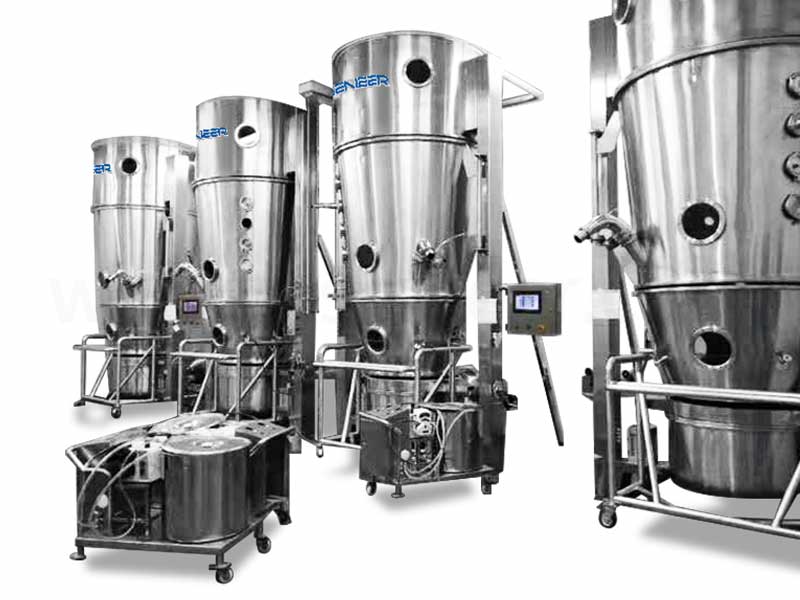
When the material is a water-absorbing material such as starch, the surface of the powder cannot be completely wetted due to the water absorption of the material, and the flow rate of the binder should be increased. Even if the same material has different water content, the flow rate of the binder should not be the same. Under the condition of the same flow rate of the binder, the higher the water content of the material, the larger the particles will be. When the material is hydrophobic and difficult to wet, it is not easy to granulate, and the resulting particles are smaller. You can try to use other solvents or add surfactants to the binder solution to improve.
The amount of material also has a great impact on granulation. When the dosage increases, in order to fluidize the material, it is necessary to increase the air intake, and at the same time, the probability of the material receiving wetting is reduced, and the spray rate should be adjusted accordingly. However, if the amount of material is too large, the material powder is not easy to reach a fluid state, and it is easy to block the nozzle and filter bag, resulting in a decrease in the fluid air volume and affecting granulation.
4.3.2 Selection Of Adhesive
The role of the binder is to form solid bridges between the powders. The type, concentration and addition method of the binder have a great influence on granulation. The choice of binder is the key to the entire fluid bed granulation process. The ideal binder should have a good affinity with the surface of the material powder to facilitate wetting and mutual bonding to form granules. Our lab used fluid bed granulation with different binders, and the obtained granules were very different in porosity and compressibility. The binders recommended by our company are mainly povidone (PVP ), carboxyl methyl cellulose ( CMC ), methyl cellulose ( MC ), cellulose acetate phthalate ( CAP ), Hydroxypropyl cellulose (HPc), gum arabic, peach gum, starch, etc., can also be used in combination to obtain the best effect.
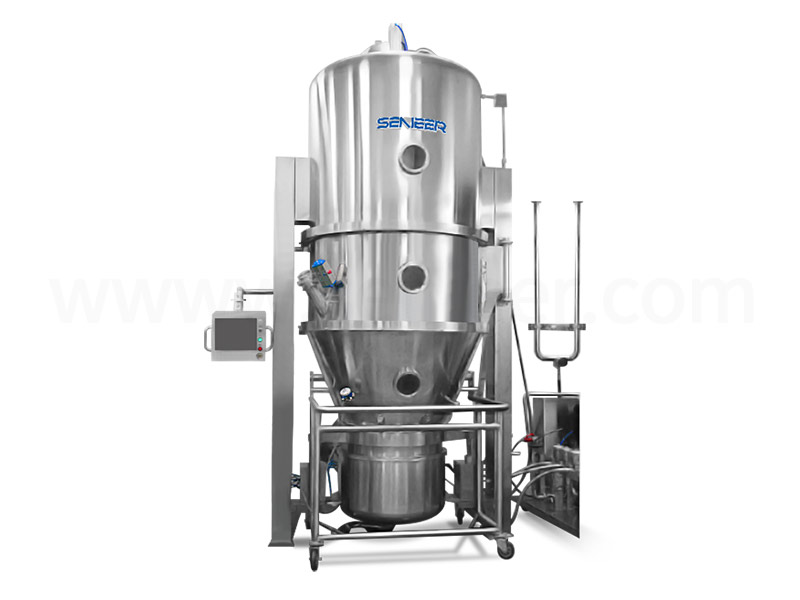
When the viscosity of the binder liquid is high, the binding force of the formed liquid bridge is relatively strong, and it has the ability to form secondary and tertiary agglomeration granulation processes between microparticles, fine particles, granules, so that the obtained particles are also larger. However, if the concentration is too high, such as using the PVP aqueous solution with a mass fraction of 10% as the binder, it will not only easily block the nozzle, but also easily cause the collapsed bed. When the concentration is low, the cohesion between the particles is insufficient, the particles obtained are small, and many fine powders are produced during the drying process, which cannot achieve the expected effect. Sometimes, the granules obtained from the alcohol solution of the binder are smaller and the fine powder is more, and an appropriate amount of water can be added to the binder solution to increase the viscosity of the binder, which can significantly improve the quality of the obtained granules. The methods of adding the adhesive include external addition, internal addition, and internal and external combination. In most cases, the first two joining methods are used. When the same kind of adhesive adopts the internal addition method, because the solvent volatilizes quickly, it is not easy to cause the viscosity of the adhesive, and it is not easy to obtain particles or the particles are smaller. When the viscosity of the adhesive such as Starr (partially pregelatinized corn starch) is particularly easy to induce, internal addition can be used, for example, when preparing 500 mg capsule-type acetaminophen tablets, as long as the mass fraction of 85% acetaminophen and 28% of Starr are used, the tablet core can achieve good hardness and less than 0.19% friability. However, when the amount of binder is small, internal addition should not be used.
5 Problems That Should Be Paid Attention To In Actual Production
In actual production, the problem of agglomeration or collapse of the bed sometimes occurs, which may be caused by the excessive flow rate and concentration of the adhesive, and the wet particles sticking together too late to dry, or the relative humidity in the fluid bed granulator. If it is too large, it exceeds the critical relative humidity of the particle itself. The flow rate of the mixture can be reduced, and water or ethanol can be added to reduce the viscosity. At the same time, the fluid air volume should be appropriately increased and the inlet temperature should be increased. At the beginning of granulation, because the temperature of the material is not completely consistent with the temperature of the fluid air, the solvent of the binder cannot be completely swept away, so the flow rate of the binder should not be too fast, and the atomization pressure should be appropriately increased. After the temperature of the material is consistent with the temperature of the fluid air, the flow rate of the adhesive should be appropriately increased and the atomization pressure should be reduced. The raw materials of traditional Chinese medicine granules are basically two types of crude drug powder and extract, usually without fillers. When using a fluid bed to prepare traditional Chinese medicine granules, if a common binder is selected, the preparation of granules cannot be completed at one time with this granulation technology alone. It is necessary to cooperate with the old process in some processes. Therefore, to achieve one-step preparation of traditional Chinese medicine granules in a fluid bed, the most desirable way is to directly replace the binder with the extract to granulate. The extract is a binder. The color of the particles and the content of active ingredients will vary with the yield of the extract. The particle structure is loose and the anti-rubbing resistance is poor. It is not ideal for direct use as a finished product. There is a significant improvement, and the surface of the tablet is highly smooth, which fully meets the requirements of sugar coating and film coating. When using extract to prepare granules, because the extract product is easy to absorb moisture, the humidity of the environment, especially the humidity of the fluid air, should be controlled.
In order to ensure the quality of medicines, the fluid bed granulation process must not pollute the production environment or the medicines. The hot air that enters the system for fluid and drying must be heated first and then filtered by medium-efficiency and sub-high-efficiency filters. If necessary, it needs to be dehumidified to ensure that the gas used is dry and clean, and does not cause pollution to drugs. Before the compressed air source required by the system enters the fluid bed, a series of measures such as dehumidification, deodorization and dust removal should also be provided. The fluid bed must be thoroughly cleaned regularly in production and use, especially when changing the variety of drugs, cleaning is more important to prevent cross-contamination of drugs and mixed batches and drugs. The filter bag is generally made of anti-static cloth, which should be carefully cleaned after each granulation. On the one hand, it is a hygiene requirement. More importantly, once the filter bag is blocked, it will not only cause a sharp decrease in the fluid air volume, but also seriously affect the fluid state of the material. Moreover, the dust in the bed will increase, and the granulation process cannot be carried out smoothly.
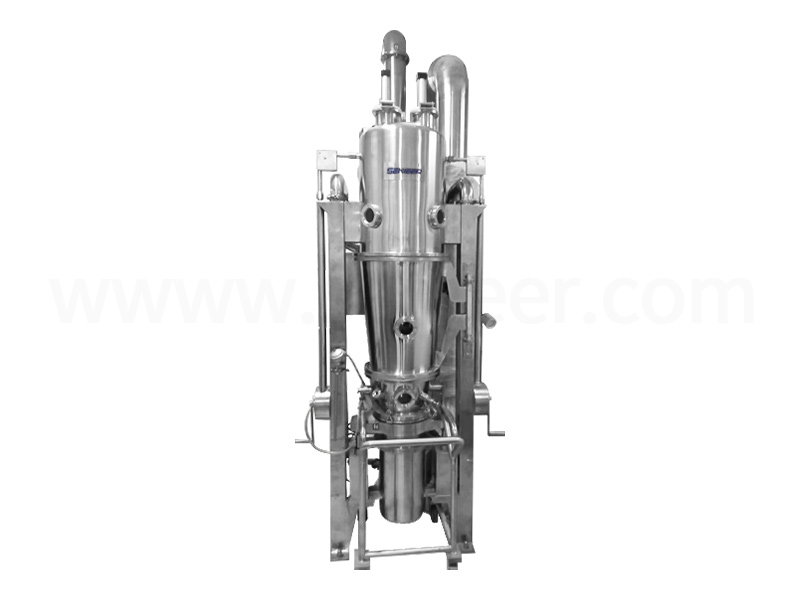
When preparing granules for filling capsules and dense spherical granules for coating, granulation in a fluid bed with rotating and stirring should be the main method.
RESULTS AND CONCLUSION: Compared with other granulation methods, fluid bed granulation has the advantages of uniform particle size, good fluidity and compression formability, and the drugs with very low content in the components are more uniformly distributed in the granules, saving production time, more in line with the requirements of GMP norms and other advantages. In the granulation process, the equipment parameters, inlet temperature, fluid air volume, the properties of the binder and the properties of the materials should be considered comprehensively.










